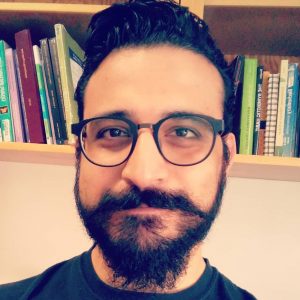Aram Mikaelyan
Bio
Publications
- Chewing through challenges: Exploring the evolutionary pathways to wood-feeding in insects , BIOESSAYS (2024)
- Fight, retreat, repeat: The male-male agonistic behavior in the wood-feeding cockroach, Panesthia angustipennis spadica (Dictyoptera: Blattodea: Blaberidae) , ECOLOGY AND EVOLUTION (2024)
- Lethal Disruption of the Symbiotic Gut Community in Eastern Subterranean Termite Caused by Boric Acid , (2024)
- Lethal disruption of the bacterial gut community in Eastern subterranean termite caused by boric acid , JOURNAL OF ECONOMIC ENTOMOLOGY (2024)
- Scaling the wall: overcoming barriers to STEM knowledge mobilization , FRONTIERS IN COMMUNICATION (2024)
- The Genome of Arsenophonus sp. and Its Potential Contribution in the Corn Planthopper, Peregrinus maidis , INSECTS (2024)
- Viability and virulence of freeze-dried Beauveria bassiana, Metarhizium acridum, and Hirsutella thompsonii isolates under non-refrigerated conditions in Ghana , BIOCONTROL SCIENCE AND TECHNOLOGY (2024)
- A call to termitologists: it is time to abandon the use of "lower" and "higher" termites , INSECTES SOCIAUX (2023)
- Chewing Through Challenges: Exploring the Evolutionary Pathways to Wood-Feeding in Insects , (2023)
- Reevaluating Symbiotic Digestion in Cockroaches: Unveiling the Hindgut's Contribution to Digestion in Wood-Feeding Panesthiinae (Blaberidae) , INSECTS (2023)
Grants
Project is in support of PSI. Drs. Huerta, Baltzegar, and Gold are pleased to submit this internal pre-proposal to NC State in support of their commitment and desire to write and submit a full-length proposal to the USDA-NIFA Equipment Grant Program, where they will lead a team of 26 other faculty requesting funds to acquire a Whole Genome Sequel IIe System sequencer from PabBio. The PacBio Sequel IIe is the current state-of-the-art technology for high-quality sequencing of genomes, transcriptomes, and epigenomes. If successful, this would be the first Sequel IIe in the University and possibly the state. The PacBio Sequel IIe system (product code 101-986-400) is priced at $525,000.00; The on-site system training (product code 100-125- 100) is $12,500; and the necessary uninterrupted power supply (UPS) (product code 100-609-000) is $7,000. The total for the instrument, installation and training for the instrument is $544,500.00. This sum is well above the funding limit for the USDA-NIFA EGP. However, Dr. Huerta has been in conversation with Dr. Nicole Newell, Sequencing Application Specialist at PacBio, to negotiate a 10% discount on the above listed sale price to bring the price down to $490,050 (see quote attached and letter of support from PacBio���s willingness to collaborate with us to make this grant and purchase a reality).
Flies are diverse models for the study of the evolution of the parasitic habit. Multiple repeated origins of specialized feeding in flies can reveal the molecular mechanisms underlying adaptive changes that both produce and sustain the parasitic lifestyle. With 1525 described species the blow flies (family Calliphoridae), are an ideal candidate for comparative study of the genetic and behavioral determinants of feeding adaptations. In this family of flies, different species have been recorded feeding on living tissues of a vertebrates, living tissues of invertebrates; decaying organic matter-- especially carrion or wound tissue; and blood. Considering the feeding habits of their larvae, blow flies are classified in: necrosaprophagous species, which feed on decomposing tissue; facultative ectoparasites, which feed on dead organic matter (necrophagous), or infest necrotic tissues of living vertebrates; and obligate parasites, which feed only on the living tissues of their hosts. For this reason, they are important as indicator organisms in forensic cases, are major agricultural pests of livestock, and they play a major role in nearly all terrestrial ecosystems as decomposers of organic material. The origin and evolutionary history of diverse specialized feeding habits in Calliphoridae are still vastly understudied, and are limited by a lack of phylogenetic, genetic and ecological information. With this project, an established team of evolutionary, ecological and genomic scientists will collaboratively investigate the causes and consequences of trophic specialization as a driver of species diversity across three integrated dimensions of blow fly research: (1) phylogenetic: reconstructing the history of blow fly evolutionary relationships and mapping the transitions of feeding habits that occurred repeatedly in the family; (2) functional, quantifying the index of preference for different food sources, and testing the effects of selection on feeding preferences; and investigating the role of the blow fly gut microbiome in mediating diet adaptations and maintaining diverse biotic interactions; and (3) genetic/genomic, identifying genes and gene regions associated with specific specialized feeding habits and using an established CRISPR Cas9 gene editing system to test hypotheses about the lability, maintenance, and control of feeding strategies in diverse blow fly models. The project includes a novel cross laboratory training and data collection for graduate students and postdocs between NCSU and Sao Paulo, Brazil, the development of an on-line data resource of genomic, taxonomic and ecological information on blow flies, and participation in multi-institutional training and research opportunities that include resources and outreach to individuals and communities that are underrepresented in science.
